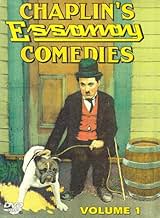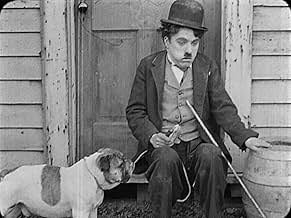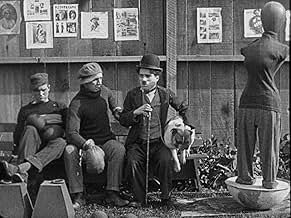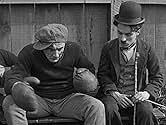AVALIAÇÃO DA IMDb
6,7/10
2,9 mil
SUA AVALIAÇÃO
Adicionar um enredo no seu idiomaWith his bulldog, Charlie finds a good luck horseshoe as he passes a boxing camp looking for someone who can take a beating. With the horseshoe in his glove, Charlie wins and earns a fight a... Ler tudoWith his bulldog, Charlie finds a good luck horseshoe as he passes a boxing camp looking for someone who can take a beating. With the horseshoe in his glove, Charlie wins and earns a fight against the world champion.With his bulldog, Charlie finds a good luck horseshoe as he passes a boxing camp looking for someone who can take a beating. With the horseshoe in his glove, Charlie wins and earns a fight against the world champion.
- Direção
- Roteirista
- Artistas
Bud Jamison
- Bob Uppercut - Champion
- (não creditado)
Gilbert M. 'Broncho Billy' Anderson
- Enthusiastic Fan
- (não creditado)
Billy Armstrong
- Sparring Partner
- (não creditado)
Lloyd Bacon
- Second Sparring Partner
- (não creditado)
- …
Bill Cato
- First Sparring Partner
- (não creditado)
- …
Frank Dolan
- Second Stretcher Bearer
- (não creditado)
W. Coleman Elam
- Bit Role
- (não creditado)
Eddie Fries
- Bit Role
- (não creditado)
Daniel P. Kelleher
- Second Cop
- (não creditado)
Paddy McGuire
- Sparring Partner
- (não creditado)
Edna Purviance
- Trainer's Daughter
- (não creditado)
Jess Robbins
- Bit Role
- (não creditado)
Carl Stockdale
- Sparring Partner
- (não creditado)
Ben Turpin
- Ringside Vendor
- (não creditado)
Ernest Van Pelt
- Spike Dugan
- (não creditado)
Leo White
- Crooked Gambler
- (não creditado)
Avaliações em destaque
I saw the 20 minutes version. It ends with his bulldog entering the ring biting and Charles Chaplin knocking out his opponent in Round 20. I guess it's missing the romantic ending. I can understand that. This version is strictly a slapstick movie.
I like quite a lot of the slapstick. Of course, there is nothing funnier than his boxing sequence in 'City Lights' (1931). Here he's trying out several things. When he's boxing fodder, he puts a horseshoe into his glove. Then during the long boxing match, he's doing a lot of what would recognizable to most people who's seen the boxing match in 'City Lights'.
I like quite a lot of the slapstick. Of course, there is nothing funnier than his boxing sequence in 'City Lights' (1931). Here he's trying out several things. When he's boxing fodder, he puts a horseshoe into his glove. Then during the long boxing match, he's doing a lot of what would recognizable to most people who's seen the boxing match in 'City Lights'.
It seems natural that at the very start of Chaplin's career he should make a movie in which he plays a grossly unqualified boxer who succeeds by sneaking horse shoes into his gloves. I only wonder why it didn't happen even earlier. He passes a sign saying that sparring partners are wanted, people who know how to take a punch, and heads in. We see him grow increasingly concerned as one guy after another, all bigger and stronger than him, get up to fight and return in a state of dazed semi-consciousness.
A lot of times when I watch these early comedies from Chaplin, I get the feeling that he is often trying to create at least a mildly engaging story throughout which he can throw in a lot of kicking and punching scenes, but in this movie it's the kicking and punching the drives the plot, giving the film an unusually honest feel.
High-energy physical slap-stick is what Chaplin did best at that time, and smacking around a huge mountain of a man while he dances carelessly around as only he can is certainly a treat to watch. And the climactic battle between Charlie and the meaty Bob Uppercut (or Young Hippo, depending on which cannibalized version you may see) is well-acted and fun.
Mack Sennett like his comedies to be fast paced and high energy, without too much time wasted on things like characterization or even story. But in The Champion, Chaplin proves that we can have well-developed characters, an easily discernible story, and still have enough action and solid slap-stick to keep the shorter attention spanned audience members entertained. This is definitely one of the best short comedies that Chaplin had made up to that point.
A lot of times when I watch these early comedies from Chaplin, I get the feeling that he is often trying to create at least a mildly engaging story throughout which he can throw in a lot of kicking and punching scenes, but in this movie it's the kicking and punching the drives the plot, giving the film an unusually honest feel.
High-energy physical slap-stick is what Chaplin did best at that time, and smacking around a huge mountain of a man while he dances carelessly around as only he can is certainly a treat to watch. And the climactic battle between Charlie and the meaty Bob Uppercut (or Young Hippo, depending on which cannibalized version you may see) is well-acted and fun.
Mack Sennett like his comedies to be fast paced and high energy, without too much time wasted on things like characterization or even story. But in The Champion, Chaplin proves that we can have well-developed characters, an easily discernible story, and still have enough action and solid slap-stick to keep the shorter attention spanned audience members entertained. This is definitely one of the best short comedies that Chaplin had made up to that point.
The real leap forward that Charlie Chaplin made in screen comedy, the thing that put him ahead of his peers, was that he staged his comedy within a straight and serious world. His first two Keystone pictures had little plot but allowed his little tramp to interact (chaotically) with a realistic environment, albeit with a handful of supporting comedy characters thrown in. With the Champion he moved on to develop stronger story lines which were not funny in themselves, but which gave the tramp a world to be funny in.
The set-up of an up-and-coming boxer who fights his way to the top, is then bribed into throwing a fight and has to choose between his integrity and the payoff was an established cliché even back then. This well-known sequence of events allows Chaplin to mess around with stereotypes or subvert conventions. For a start, there is the fact that Charlie is a scrawny little feller, who essentially cheats his way to the championship. Then there's the farcical training routine, which Chaplin cross-cuts with the opponents more serious routine to give it more comedy impact, followed by the tramp's nonchalant seeing-off of Leo White's over-the-top sinister villain.
Throughout Chaplin is showing more confidence in his staging and arrangements. He allows himself to become a more marginal figure in some sequences – for example when Spike Duggan is knocking out one challenger after another, Charlie isn't doing very much, and is off-screen half the time, but it's his reactions to the growing number of defeated men that is funny. The other characters simply act naturally, whereas Chaplin is the originator of all the comedy.
In Chaplin's previous picture, A Night Out, he came dangerously close to becoming a double-act with Essanay's resident comic Ben Turpin. A large part of Chaplin's humour was based on reacting to other comedy characters, so he needed to have his supporting cast of burly bullies and pompous twerps to antagonise. However in the Champion you can see he is being careful not to let any of them have too much screen time. Although Bud Jamison, Leo White and Ernest van Pelt all do a great job, each of them is a walk-on, walk-off character; none of them shares the picture with Charlie. Ben Turpin has a tiny part as a vendor, but even in this one-shot role he manages to violate Chaplin's rule of the tramp being at the comedic centre of attention, stealing the laughs as he scrambles over the crowd to reach a customer. This would be Turpin's last picture with Chaplin.
And now, we finish with the all-important statistic – Number of kicks up the arse: 1 (1 for, 0 against)
The set-up of an up-and-coming boxer who fights his way to the top, is then bribed into throwing a fight and has to choose between his integrity and the payoff was an established cliché even back then. This well-known sequence of events allows Chaplin to mess around with stereotypes or subvert conventions. For a start, there is the fact that Charlie is a scrawny little feller, who essentially cheats his way to the championship. Then there's the farcical training routine, which Chaplin cross-cuts with the opponents more serious routine to give it more comedy impact, followed by the tramp's nonchalant seeing-off of Leo White's over-the-top sinister villain.
Throughout Chaplin is showing more confidence in his staging and arrangements. He allows himself to become a more marginal figure in some sequences – for example when Spike Duggan is knocking out one challenger after another, Charlie isn't doing very much, and is off-screen half the time, but it's his reactions to the growing number of defeated men that is funny. The other characters simply act naturally, whereas Chaplin is the originator of all the comedy.
In Chaplin's previous picture, A Night Out, he came dangerously close to becoming a double-act with Essanay's resident comic Ben Turpin. A large part of Chaplin's humour was based on reacting to other comedy characters, so he needed to have his supporting cast of burly bullies and pompous twerps to antagonise. However in the Champion you can see he is being careful not to let any of them have too much screen time. Although Bud Jamison, Leo White and Ernest van Pelt all do a great job, each of them is a walk-on, walk-off character; none of them shares the picture with Charlie. Ben Turpin has a tiny part as a vendor, but even in this one-shot role he manages to violate Chaplin's rule of the tramp being at the comedic centre of attention, stealing the laughs as he scrambles over the crowd to reach a customer. This would be Turpin's last picture with Chaplin.
And now, we finish with the all-important statistic – Number of kicks up the arse: 1 (1 for, 0 against)
With lots of good material, an interesting (if humorously implausible) story, and some secondary characters that are used well, "The Champion" is a very good short comedy, and is easily one of the best of Charlie Chaplin's early comedies.
It begins with Charlie answering a prize-fighter's request for sparring partners, and starting from there Chaplin gets involved in some adventures that, though lacking any believability, are quite amusing. Most of the sequences make use of the secondary characters more than is usual for Chaplin's early features. Early in the story, while Charlie and the other fighters are waiting for their turn, it makes good use of the mannerisms and expressions of the others, as well as Chaplin himself. In the main fight scene, the activity in the ring is funny, creative, and well-choreographed - there are moments when it is almost as good as the celebrated boxing scene in "City Lights". That's not to say, of course, that overall this short movie approaches such a standard of greatness, but it is a well-made and entertaining little comedy.
It begins with Charlie answering a prize-fighter's request for sparring partners, and starting from there Chaplin gets involved in some adventures that, though lacking any believability, are quite amusing. Most of the sequences make use of the secondary characters more than is usual for Chaplin's early features. Early in the story, while Charlie and the other fighters are waiting for their turn, it makes good use of the mannerisms and expressions of the others, as well as Chaplin himself. In the main fight scene, the activity in the ring is funny, creative, and well-choreographed - there are moments when it is almost as good as the celebrated boxing scene in "City Lights". That's not to say, of course, that overall this short movie approaches such a standard of greatness, but it is a well-made and entertaining little comedy.
The Champion is a simple little front for great physical comedy in the context of a sports movie. Charlie Chaplin is the real champion of the story, ensuring that at 30 minutes of silent movie length The Champion is a sufficiently entertaining comedy loaded with the entertaining slapstick and comedic dynamics that make him the iconic comedian he is today. It's a fun venture, moving him from being the sophisticated man in a suit to being an unusually talented boxer. It maintains a classical feel with much of the original vaudeville atmosphere to it, and supplies a good slap of many sticks from the hands of the man himself, Charlie Chaplin.
Você sabia?
- CuriosidadesThe film was restored in 2014 through the Chaplin Essanay Project thanks to the financial support of the Niles Essanay Silent Film Museum.
- ConexõesEdited into Chase Me Charlie (1918)
Principais escolhas
Faça login para avaliar e ver a lista de recomendações personalizadas
Detalhes
- Data de lançamento
- País de origem
- Centrais de atendimento oficiais
- Idiomas
- Também conhecido como
- Charlie the Champion
- Locações de filme
- Empresa de produção
- Consulte mais créditos da empresa na IMDbPro
- Tempo de duração
- 31 min
- Cor
- Mixagem de som
- Proporção
- 1.33 : 1
Contribua para esta página
Sugerir uma alteração ou adicionar conteúdo ausente

































